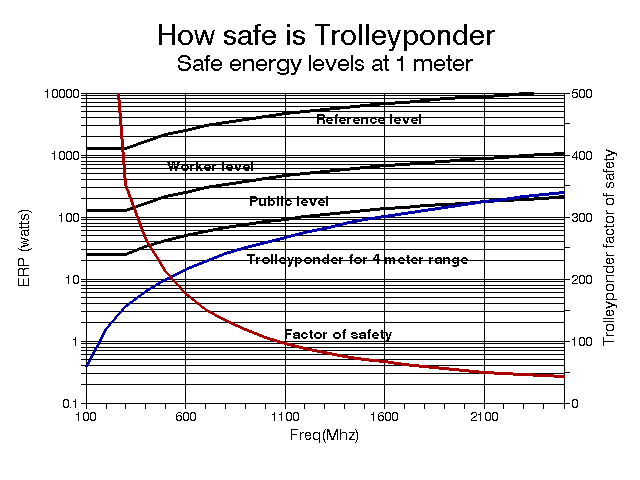

 Trolley Scan(Pty) Ltd
Trolley Scan(Pty) Ltd
Trolleyponder(TM)
How safe are Trolleyponder RF systems?
The unknown features of Radio Frequency
power radiation causes concern for some users,
and yet they still love cell phones!
A major concern for any designer or manufacturer of systems is, how safe is it?
Electric coupled Passive RFID transponder systems use the principle of the transmitter radiating power from the reader to the transponders, and that power being used to provide the operating voltages for the transponders. This principle requires the transfer of energy from the reader to the transponders.
The IEEE and ANSI on the United States and the European Committee for Electrotechnical Standardisation (CENELEC) in the European Community have investigated in depth the radiation hazards of radio frequency emmisions with regard to human safety.
The standards have been published as
IEEE C95.1-1991 IEEE Standard for Safety Levels with Respect to Human
Exposure to Radio Frequency Electromagnetic Fields, 3kHz to 300 GHz
(75 pages)
ENV 50166-2 Human exposure to electromagnetic fields - High frequency (10kHz to 300 GHz)(41 Pages)
To summarise these comprehensive documents
These standards develop guidelines for the continuous exposure of humans
to radio energy at different frequencies. Both standards develop a reference
level, that is the level at which humans are aware that radio energy is
present but which is not harmful for continuous exposure. This reference
level is regularly reverified by examination and review of current research.
The committees have then recommended an addition factor of safety of 10 times for workers and 50 times for the general public to make sure that exposure is not harmful.
The exposures are expressed as a power density, that is the radiated power is dissipated over an area. The following graph summarises these recommendations, and is based on the radiation happening from a point source one meter away from the human. In these curves the distance was chosen as 1 meter which is a practical distance for an RFID system. If the distance is too short, the measurement happens in the near field zone of the antenna which will give different measurements to what happens in the far field zone by which time the wavefronts are radiating radially.
Curves have also been shown for a typical Trolleyponder system should it be required to operate over a four meter range. The ERP for the Trolleyponder system to operate over the four meter range was then compared against the reference level and the factor of safety determined.

The graph shows that for a 915MHz Trolleyponder system, the exposure to a human 1 meter from the reader would be less than 125 times below the reference level determined by the safety committees. In fact it would be even safer as the reference level is for continuous exposure and the Trolleyponder system is only activated for short periods to read the identities of goods in the reading zone.
Mike Marsh
13 November 1998
Note
On the 3rd May 1999 Trolley Scan announced the development of a technology
called EcoTag, specifically aimed at meeting the European restrictions
of 0.5 watts ERP for RFID systems. With EcoTag, despite the severe power
restrictions, ranges of 10 meters are possible. EcoTag power density at
1 meter is 0.04Watts/sq meter..